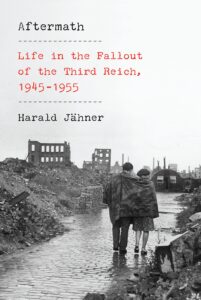
Aftermath: Life in the Fallout of the Third Reich, 1945-1955
by Harald Jähner
trans. by Shaun Whiteside
Knopf
416 pp., $30.00
Historians of Germany, and the Germans themselves, have long wrestled with the question of how to understand the end of the Second World War in Europe. Recognizing that there is good reason to consider it Hitler’s War, the Germans have to decide whether it was Germany’s war, too. Thus, generations debated whether the end of fighting in May 1945 constituted a defeat or a liberation. If the former, then the Germans had to accept responsibility for a Nazi regime that had promised a world empire and left behind so much physical and moral devastation; if the latter, then the Germans could count themselves among the victims of Nazism and perhaps thus evade direct responsibility for the crimes that they had known about but had assiduously pretended not to notice for so long.
This debate reached a climax in 1985, at the 40th anniversary of the end of the war, when West German Federal President Richard von Weizsäcker delivered a powerful speech reflecting on the dual nature of the anniversary, concluding that defeat and liberation could not be separated. The Germans had to reflect upon their historical responsibility even as they could also celebrate the democratic development that emerged from the rubble of the thousand-year Reich.
Weizsäcker’s speech resonated in a late-Cold War West Germany—which was only just becoming comfortable with its role as an important part of the international community—and continues even now to shape the broad German consensus on the Nazi past. Nevertheless, the question of how the Germans managed to recover from the war and (in the Western zones, at least) to construct a stable and prosperous republic continues to fascinate.
Clearly, the impact of Allied policy is significant in this recovery—from the practical help that came with the Marshall Plan to the political pressure exerted in denazification procedures. Even if the latter fell far short of eliminating all former Nazis from public life, it did place clear limits on the public airing of Nazi beliefs and thus encouraged Germans to adapt to the new political regime created in the aftermath of the war.
International politics also played a vital role. The emerging Cold War offered West Germans the opportunity to work with their former enemies against the Soviet threat, most visibly in the Berlin Airlift. The airlift transformed the former capital of the Reich from a target of allied bombers into a city on the “front lines of freedom,” where many American and British pilots dropped candies to children alongside life-saving supplies.
West German domestic politics also contributed to recovery. The Christian Democratic Union under Konrad Adenauer offered a pro-Western, center-right political movement to govern the Federal Republic for two decades, showing the Germans that a republic could offer stability and security, and proving, as in the title of the 1956 bestseller, that “Bonn is not Weimar.”
Even with these structural factors providing the framework for German recovery, however, it was largely up to the German people themselves to make sense of the war and to commit themselves to reconstruction, a process shaped by millions of individual decisions. In his new book—which, in its original German, won the prestigious 2019 Leipzig Book Fair Prize and was already gathering laurels before the arrival of this brilliant English translation—Harald Jähner offers a panoramic view of those millions of stories by describing the process of recovery for Germans in all occupation zones during the first 10 years after the guns fell silent.
As is made clear by his choice of time frame, which covers years both before and after the establishment of the two German states in 1949, Jähner does not offer a standard political narrative, though he does make occasional gestures in the direction of those big events that shaped postwar Germany. His focus, rather, is on the everyday lives of Germans in the rubble. He immediately dispenses with the notion of Stunde Null (“Zero Hour”), which Germans once used to describe the feeling of starting completely from scratch. He emphasizes how the Germans who rebuilt their society after 1945 were largely the same people who had participated, to a greater or lesser extent, in its destruction. That human continuity makes the changes he traces that much more fascinating.
In chapters covering large issues—such as the problems of exiles from the East and other displaced persons, the search for housing amid the ruins, the reconstruction of both the economy and culture under the watchful eye of Allied “reeducators,” and the reordering of family life and gender roles in a world where so many men had been shattered in body and mind (if they came home at all)—Jähner consults a wide range of contemporary sources and memoirs. The richness of his sources is only slightly soured by a terrible editorial decision to print the endnotes in endless blocks of text, though that complaint will likely only register with scholars eager to trace Jähner’s research.
Jähner finds a variety of specific individuals to highlight the changes he chronicles. His cast of characters includes the dashing Hungarian émigré journalist Hans Habe, who returned to Germany in an American uniform to establish the influential newspaper Die Neue Zeitung, which contributed mightily to postwar German culture, as well as the acclaimed novelist Alfred Döblin, whose return in a French uniform foundered on the resistance of his fellow writers to his ideas promoting intellectual reconstruction.
Jähner describes in detail the transformation of Wolfsburg—which began as a “misbegotten human plantation” made up of a collection of barracks around a Nazi automobile factory—into the thriving industrial heart of the Economic Miracle, where those odd little “Strength Through Joy” cars became world famous as the Volkswagen Beetle. That success he attributes to the work of industrial legend Heinrich Nordhoff, who applied a combination of modern industrial practices and disciplinary paternalism that pointed the way to a new social model. Jähner’s puckish creativity can be seen in his other choice of an exemplary Economic Miracle Worker: the marital-aid magnate, Beate Uhse, who built an empire on the needs of German married couples to rediscover intimacy after years of separation and deprivation.
Jähner is alive to the paradoxes and ironies of the German story. He notes, for example, how the shortages of the immediate postwar years made criminality so widespread among “respectable” middle-class Germans that even the Church hierarchy blessed it. When Cardinal Archbishop Josef Frings of Cologne announced that it was understandable that people might pilfer coal from passing trains, Rhinelanders created a new verb for the practice: “fringsen.” But those who participated in such criminality, who traded on the black market and selectively looted ruined houses to survive, did not push Germany into permanent lawlessness. In fact, Jähner notes (no doubt thinking of the older generation that raised him),
after the end of the years of hardship, the black-market generation developed into one of the most law-abiding in history. Seldom could a population have, on balance, given the police so little work as that of the two German states in the 1950s and they would also be liberally mocked for their eager conformity.
All of those ironies bring the reader back to the knotty problem of how the Germans reckoned with their past. Jähner writes that “the collective agreement of most Germans to count themselves among Hitler’s victims amounts to an intolerable insolence,” but he also concludes that “for the establishment of democracy in West Germany … it was a necessary prerequisite because it formed the mental basis for a new beginning.” At both the individual level and the level of politics, many Germans were willing to look the other way about the past: “According to the spirit of the age it was not important where someone came from, but only where they wanted to go.” After the recovery, the children of this generation would criticize their parents for their silences and repressed memories. By then, however, German society had stabilized to the point that they could engage in such self-assessment, a process that continues to the present day.
Jähner’s story includes much misery and struggle. The original German title, Wolfszeit (“Time of the Wolves”), is a much bleaker contemporary term for the postwar years than the relatively anodyne Aftermath. Nevertheless, Jähner ends on a hopeful note. Recognizing the imperfect nature of Germany’s historical reckoning, he suggests a society should not expect idealized perfection in its understanding of its past. Quoting the philosopher Karl Jaspers, Jähner concludes with a plea for dialogue and an awareness of complexity: “Grasping what we hold in common within contradiction is more important than hastily fixing exclusive standpoints with which the conversation draws hopelessly to an end.”
Like it or not, life goes on.



Leave a Reply